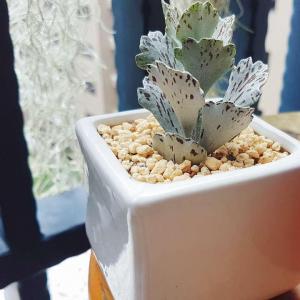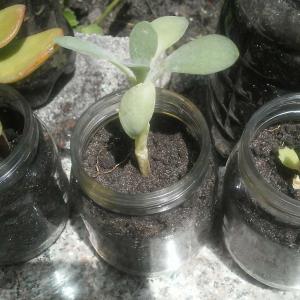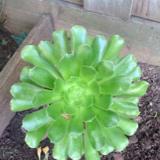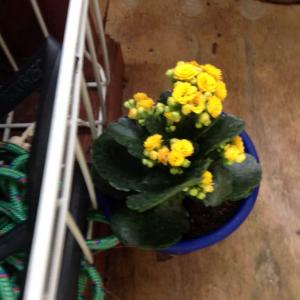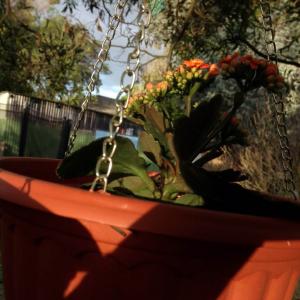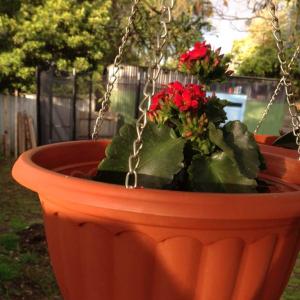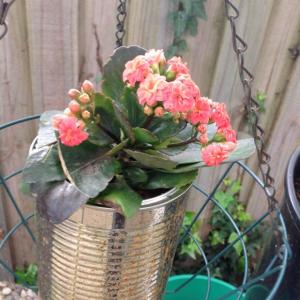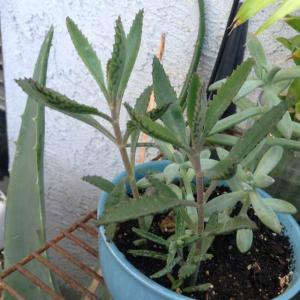成长记
meriunkat
2017年09月10日

I new added a "Bryophyllum Delagonse Kalanchoe "Chandelier plant"" in my "garden"


1
0
meriunkat:@FrancinieCR thanks 😆
FrancinieCR:Beautiful!
文章
Miss Chen
2017年08月30日

La Kalanchoe pinnata, Bryophyllum pinnatum, también es conocida por otros nombres como hoja del aire, planta de Goethe, Ojaransín, flor de arete, siempreviva, hojerilla, tronador o yerba de bruja. También hay otras variedades de esta planta como son la Kalanchoe gastonis-bonnieri y la kalanchoe daigremontiana.

Esta planta medicinal pertenece a la familia Crassulaceae originaria de Madagascar y la India, formando parte de la medicina tradicional o Ayurveda, también crece en otros lugares con climas cálidos y templados. En zonas del centro y sur de américa también se utiliza por sus cualidades curativas.
Es una planta que puede llegar a alcanzar un metro de altura y que posee unas hojas carnosas. Las flores crecen en inflorescencias y pueden tener colores diferentes como el rojizo, amarillo o verde.
Con fines medicinales se utilizan las hojas de Kalanchoe, las cuales se pueden preparar para aplicar de forma externa o interna. Para uso interno se puede preparar en infusión, se pueden añadir las hojas a platos como ensaladas o también se puede beber su jugo. Para el uso externo se pueden usar las hojas haciendo emplastos o cataplasmas y también se puede masajear la zona con el jugo extraído de las hojas. Por ejemplo, para el dolor de cabeza se pondrían las hojas ligeramente machacadas sobre la frente y nuca, o para cólicos y dolores abdominales se pondrían sobre esta zona para aliviarlos.
Propiedades medicinales de la Kalanchoe pinnata, Bryophyllum pinnatum
Esta planta medicinal contiene fenoles, acetatos y flavonoides, entre algunos de sus componentes, que proporcionan acción antiinflamatoria, hepatoprotectora, antihemorrágica, anticancerígena, antitusiva, diurética, antihistamínico, antiséptica, antidiabética, antibacteriana, antiálgica, antiulcerosa, emoliente, digestiva y antiviral.
Beneficios y usos medicinales de la Kalanchoe pinnata
kalanchoeProtege el hígado
Reduce la fiebre

Alivia enfermedades de las vías respiratorias
Se utiliza para tratar las células cancerosas
La kalanchoe es usada para la tos
Para las hemorragias
Mejora las digestiones
Es muy útil para las úlcera de estómago
Está indicada para diabéticos
Mitiga los cólicos renales
Alivia los dolores en general
Mejora las infecciones
Ayuda a reducir la hipertensión
Es beneficiosa en casos de bronquitis
Combate el herpes y otros virus
Se usa para curar las heridas
La kalanchoe mejora la uretritis
Evita la retención de líquidos
Alivia el reumatismo
Es sedante y relajante muscular
Corta las diarreas
Se utiliza para aliviar el empacho
Mejora las afecciones de la piel
Acelera la recuperación de resfriados y gripes
Elimina los abscesos
Alivia la cefalea o dolor de cabeza
La kalanchoe se usa para la sarampión
Reduce el dolor de estómago
Estimula el funcionamiento de los riñones
Su consumo no está recomendado durante el embarazo

Esta planta medicinal pertenece a la familia Crassulaceae originaria de Madagascar y la India, formando parte de la medicina tradicional o Ayurveda, también crece en otros lugares con climas cálidos y templados. En zonas del centro y sur de américa también se utiliza por sus cualidades curativas.
Es una planta que puede llegar a alcanzar un metro de altura y que posee unas hojas carnosas. Las flores crecen en inflorescencias y pueden tener colores diferentes como el rojizo, amarillo o verde.
Con fines medicinales se utilizan las hojas de Kalanchoe, las cuales se pueden preparar para aplicar de forma externa o interna. Para uso interno se puede preparar en infusión, se pueden añadir las hojas a platos como ensaladas o también se puede beber su jugo. Para el uso externo se pueden usar las hojas haciendo emplastos o cataplasmas y también se puede masajear la zona con el jugo extraído de las hojas. Por ejemplo, para el dolor de cabeza se pondrían las hojas ligeramente machacadas sobre la frente y nuca, o para cólicos y dolores abdominales se pondrían sobre esta zona para aliviarlos.
Propiedades medicinales de la Kalanchoe pinnata, Bryophyllum pinnatum
Esta planta medicinal contiene fenoles, acetatos y flavonoides, entre algunos de sus componentes, que proporcionan acción antiinflamatoria, hepatoprotectora, antihemorrágica, anticancerígena, antitusiva, diurética, antihistamínico, antiséptica, antidiabética, antibacteriana, antiálgica, antiulcerosa, emoliente, digestiva y antiviral.
Beneficios y usos medicinales de la Kalanchoe pinnata
kalanchoeProtege el hígado
Reduce la fiebre

Alivia enfermedades de las vías respiratorias
Se utiliza para tratar las células cancerosas
La kalanchoe es usada para la tos
Para las hemorragias
Mejora las digestiones
Es muy útil para las úlcera de estómago
Está indicada para diabéticos
Mitiga los cólicos renales
Alivia los dolores en general
Mejora las infecciones
Ayuda a reducir la hipertensión
Es beneficiosa en casos de bronquitis
Combate el herpes y otros virus
Se usa para curar las heridas
La kalanchoe mejora la uretritis
Evita la retención de líquidos
Alivia el reumatismo
Es sedante y relajante muscular
Corta las diarreas
Se utiliza para aliviar el empacho
Mejora las afecciones de la piel
Acelera la recuperación de resfriados y gripes
Elimina los abscesos
Alivia la cefalea o dolor de cabeza
La kalanchoe se usa para la sarampión
Reduce el dolor de estómago
Estimula el funcionamiento de los riñones
Su consumo no está recomendado durante el embarazo
0
0
Ueca
2017年08月22日

An arrangement incorporating Echeveria, Sedum, Crassula, Graptopetalum, and Kalanchoe.


1
0
文章
Dummer. ゛☀
2017年08月13日

The indoor panda plant is a hardy succulent that makes an interesting addition to the houseplants you grow indoors. Often a favorite of children, growing Kalanchoe panda plants are a good specimen to locate in a child’s room as part of the décor. Keep reading to answer the question of what is Kalanchoe tormentosa and how to grow a panda plant indoors.
What is a Panda Plant (Kalanchoe Tomentosa)?
More than 100 varieties of Kalanchoe grow in the wilds of Africa and other parts of the Old World. Kalanchoe tomentosa grows wild on the island of Madagascar. In its native environment, growing Kalanchoe panda plants have a woody base and reach several feet. As an indoor plant, however, panda plant growth is limited by the size of the container, usually reaching only 1 to 2 feet in height and 2 feet around. Further information on growing Kalanchoe panda plants says the velvety appearance of the leaves is created by hairs that spring up in trichomes, deflecting light and limiting transpiration. Brownish red markings on leaf edges, along with the white-silvery hairs, are similar to the fur of a panda bear. Tomentosa means densely woolly or velvety. The plant is also commonly called pussy ears as well.
How to Grow a Panda Plant
Locate the indoor panda plant in medium to bright light. As with most succulents, soil should be allowed to dry between waterings. In fact, watering is a limited part of panda plant care. When you do water, do so completely while giving the plant the infrequent drink. You’ll find humidity is not an issue when learning how to grow a panda plant successfully. The average room provides enough humidity for this easy-care, furry plant. The indoor panda plant can live for many years in these conditions. Move it outside during spring and summer, if desired, but provide protection from hot afternoon sun. Fertilize during these months with a balanced houseplant food mixed at half strength as a part of panda plant care.
Propagating Indoor Panda Plant
When you’re growing Kalanchoe panda plants, you’ll likely find more areas in the home that would benefit from one of these plants. Propagation of the indoor panda plant is easy and an inexpensive way to get more of the plants. Root leaves of the plant in spring or summer in a sandy potting soil or a perlite mixture. New roots develop and the plant will grow new leaves, at which time it should be transferred into a new container. Blooms are rare when growing Kalanchoe panda plants indoors. If you wish to grow a Kalanchoe with regular indoor blossoms, look to the cultivar Kalanchoe blossfeldiana hybrids.

What is a Panda Plant (Kalanchoe Tomentosa)?
More than 100 varieties of Kalanchoe grow in the wilds of Africa and other parts of the Old World. Kalanchoe tomentosa grows wild on the island of Madagascar. In its native environment, growing Kalanchoe panda plants have a woody base and reach several feet. As an indoor plant, however, panda plant growth is limited by the size of the container, usually reaching only 1 to 2 feet in height and 2 feet around. Further information on growing Kalanchoe panda plants says the velvety appearance of the leaves is created by hairs that spring up in trichomes, deflecting light and limiting transpiration. Brownish red markings on leaf edges, along with the white-silvery hairs, are similar to the fur of a panda bear. Tomentosa means densely woolly or velvety. The plant is also commonly called pussy ears as well.

How to Grow a Panda Plant
Locate the indoor panda plant in medium to bright light. As with most succulents, soil should be allowed to dry between waterings. In fact, watering is a limited part of panda plant care. When you do water, do so completely while giving the plant the infrequent drink. You’ll find humidity is not an issue when learning how to grow a panda plant successfully. The average room provides enough humidity for this easy-care, furry plant. The indoor panda plant can live for many years in these conditions. Move it outside during spring and summer, if desired, but provide protection from hot afternoon sun. Fertilize during these months with a balanced houseplant food mixed at half strength as a part of panda plant care.

Propagating Indoor Panda Plant
When you’re growing Kalanchoe panda plants, you’ll likely find more areas in the home that would benefit from one of these plants. Propagation of the indoor panda plant is easy and an inexpensive way to get more of the plants. Root leaves of the plant in spring or summer in a sandy potting soil or a perlite mixture. New roots develop and the plant will grow new leaves, at which time it should be transferred into a new container. Blooms are rare when growing Kalanchoe panda plants indoors. If you wish to grow a Kalanchoe with regular indoor blossoms, look to the cultivar Kalanchoe blossfeldiana hybrids.
4
4
文章
Dummer. ゛☀
2017年08月13日

By the time the leaves change and the first storms of winter approach, the intrepid gardener is itching for some living green thing to nurture and bring color to the home. Flaming katy kalanchoe is an ideal plant to chase away the winter doldrums. In most zones the plant is used as an interior plant, but growing flaming katy outdoors is possible in the warmer climates. The shiny green, scalloped leaves and brilliant flowers enliven any situation and care for flaming katy is a breeze. Discover how to grow flaming katy plants and charge up your interior with some vibrant tones and unique foliage.
Information on Flaming Katy Kalanchoe
Flaming katy is grouped with the succulent variety of plants. This lovely specimen if often found in the gift floral section of your local supermarket or big box nursery, but don’t let its availability fool you. Flaming katy houseplant is a spectacle to behold, especially if you are starved for color and a new plant buddy. The leaves are thick and waxy like a jade plant but have a sculpted edge. Plants get about 12 inches high and just a little smaller in width. The flowers are a real show stopper in bright colors like pink, yellow, orange and red. The plants require well drained soil and prefer drier conditions. Flaming katy houseplants that get overwatered will show their displeasure with yellowing, dropping leaves and rotten stems.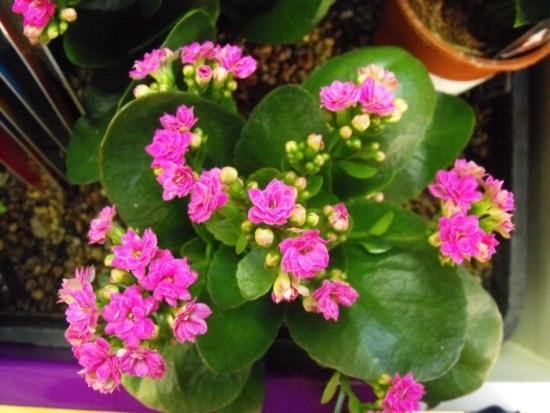
How to Grow Flaming Katy Plants
Kalanchoe is familiar as a houseplant but it is possible to grow them outside too. They need bright sun and temperatures of 65 to 70 F. (18-21 C.). The plants are native to Madagascar and do not tolerate boggy soil, cold temperatures or shade. Even a light freeze can kill the plant, but it makes an excellent patio plant in summer. Bring it inside when cold temperatures threaten and use it as a houseplant. Growing this plant from seed is not recommended. Starts are relatively cheap and thrive and grow quickly in sun to part shade. Lower light conditions promote greener foliage and the plants will still fill with blooms. Flaming katy kalanchoe needs at least six weeks of shorter days and up to 12 for more compact blooms. Use a sandy potting mix for container outdoor plants and amend garden beds with plenty of grit to ensure drainage. You rarely need to water unless you have endlessly hot, dry days. Apply water from the base of the plant to prevent water spotting and rot on the leaves. Allow the top of the soil to completely dry out before watering again.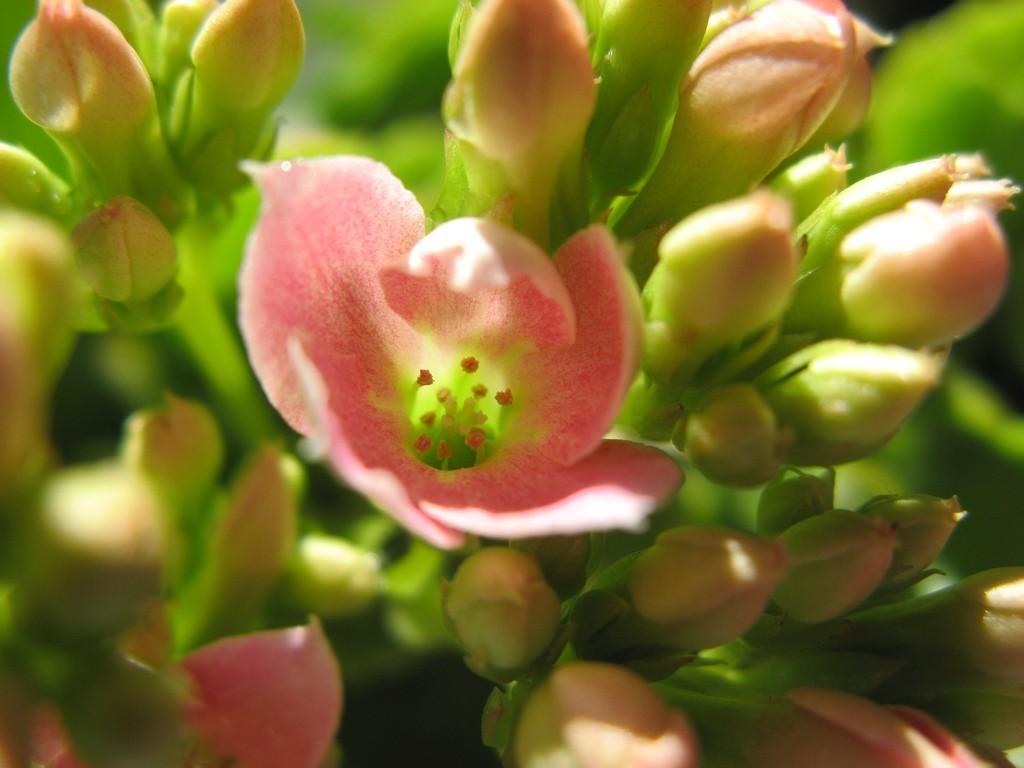
The importance of not overwatering cannot be stressed enough. The moderate moisture needs of the plant are one of the keys to care for flaming katy. During the blooming season, fertilize monthly with a diluted flowering plant food. Remove spent flowers and pinch off any dead leaves to enhance the appearance of the plant. It is a lovely foliage plant even when not in bloom and the thick leaves store moisture. Lightly wrinkled leaves signal that it is time to water. Follow these hints on care for flaming katy and you will have a proven winner for many seasons to come.

Information on Flaming Katy Kalanchoe
Flaming katy is grouped with the succulent variety of plants. This lovely specimen if often found in the gift floral section of your local supermarket or big box nursery, but don’t let its availability fool you. Flaming katy houseplant is a spectacle to behold, especially if you are starved for color and a new plant buddy. The leaves are thick and waxy like a jade plant but have a sculpted edge. Plants get about 12 inches high and just a little smaller in width. The flowers are a real show stopper in bright colors like pink, yellow, orange and red. The plants require well drained soil and prefer drier conditions. Flaming katy houseplants that get overwatered will show their displeasure with yellowing, dropping leaves and rotten stems.

How to Grow Flaming Katy Plants
Kalanchoe is familiar as a houseplant but it is possible to grow them outside too. They need bright sun and temperatures of 65 to 70 F. (18-21 C.). The plants are native to Madagascar and do not tolerate boggy soil, cold temperatures or shade. Even a light freeze can kill the plant, but it makes an excellent patio plant in summer. Bring it inside when cold temperatures threaten and use it as a houseplant. Growing this plant from seed is not recommended. Starts are relatively cheap and thrive and grow quickly in sun to part shade. Lower light conditions promote greener foliage and the plants will still fill with blooms. Flaming katy kalanchoe needs at least six weeks of shorter days and up to 12 for more compact blooms. Use a sandy potting mix for container outdoor plants and amend garden beds with plenty of grit to ensure drainage. You rarely need to water unless you have endlessly hot, dry days. Apply water from the base of the plant to prevent water spotting and rot on the leaves. Allow the top of the soil to completely dry out before watering again.

The importance of not overwatering cannot be stressed enough. The moderate moisture needs of the plant are one of the keys to care for flaming katy. During the blooming season, fertilize monthly with a diluted flowering plant food. Remove spent flowers and pinch off any dead leaves to enhance the appearance of the plant. It is a lovely foliage plant even when not in bloom and the thick leaves store moisture. Lightly wrinkled leaves signal that it is time to water. Follow these hints on care for flaming katy and you will have a proven winner for many seasons to come.
0
0



